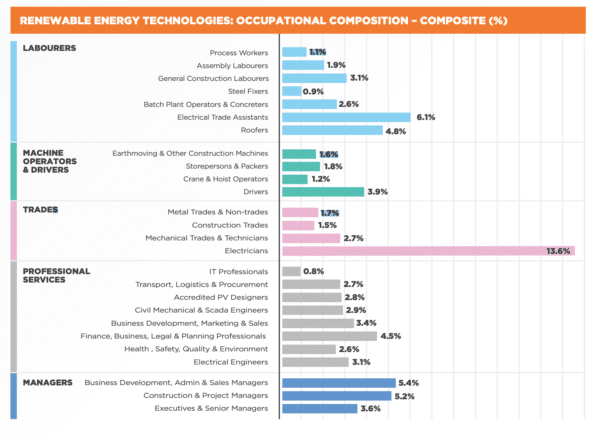Everyone recognises that renewable energy projects, whether on a small scale like residential rooftop solar, or on a massive scale like the Snowy 2.0 pumped hydro energy storage project, create far more employment in the build than they do in permanent long-term management — this ongoing low-maintenance electricity generation from ‘free’ sources of energy contributes to its low cost. But a new report, released on Friday by the Australian Council of Trade Unions (ACTU), argues for Sharing the Benefits with Workers: A decent jobs agenda for the renewable energy industry.
The report says that despite the fact that the renewables sector is one of the fastest growing in the Australian economy, and at the end of 2019 employed around 27,000 people, far too many of those roles are “short term, insecure and poorly paid, compared to equivalent jobs in carbon-intensive energy production”, at fossil-fuelled power stations and in coal mines.
The ACTU report draws on last year’s industry-first, a survey of employment in renewables commissioned by the Clean Energy Council — a peak body representing employers, businesses and workers in the renewables sector. Its resulting study, Clean Energy at Work, published in June 2020, confirmed that today 80% of jobs in the renewables sector are associated with manufacture, development and construction of projects, but that by 2035, almost 50% of roles could be in operations and maintenance, and that these jobs would be predominantly on large-scale wind-farm projects.
The ACTU contends that even in this instance, “there is a risk that these jobs are outsourced to contractors rather than being permanently located in the host communities”.
The knock-on effects on workers of inconsistent government policies
It says “chaotic policy settings” that saw the industry aim for 41,000 GWh under the original Renewable Energy Target, which was then slashed to 33,000 GWh in 2015 by the Liberal coalition, have resulted in “corporate churn”, takeovers and divestments among developers and owners of large-scale renewables.
As a result, annual installations of renewable energy projects have “fluctuated wildly”, it says, creating barriers to the establishment of a stable clean-energy workforce, with accompanying investment in its training and development.
Competition among developers and engineering, procurement and construction (EPCs) companies to deliver projects at the lowest cost per megawatt hour has squeezed budgets: “For investment in new renewable energy generation to stack up financially, generation costs need to be competitive with existing fossil fuel assets, many of which were built with public funds decades ago,” reminds the ACTU.
So the “race to the bottom of the cost curve”, a point of both pride and necessity in the renewables industry, has exacerbated a tendency to “shoehorn” wages and conditions into agreements that have locked in the lowest-possible costs of finance and construction as the main priority.
Solar, the big employer
Although operation and maintenance of wind farms is forecast to be a future growth area for renewable jobs, the CEC found that more than half of all clean energy jobs in 2019 were in developing, building and maintaining Australia’s solar capacity.
The residential and small-commercial rooftop sector, currently employs 37% of the clean energy workforce, and, the CEC says, “A large proportion of the businesses installing small-scale solar are small to medium sized that employ fewer than 20 people.”
The ACTU found many small operators have been trapped in what it calls the “cut-throat pricing environment in the budget end of the solar market”, which provides a poor basis for business longevity, worker safety and employment security and conditions.
In the large-scale solar sector, which accounts for some 13% of the renewable energy workforce, the ACTU argues that social license for renewable projects has been focused around the perceived largest risk factor of local objection to projects, and therefore prioritised “keeping the neighbours happy” and funding community aims over the development life cycle.
Although the concept of community benefits often encourages local hiring and local job creation “these practices are relatively under developed”, compared with other benefit-sharing approaches, says the ACTU report.
The chicken-and-egg of skills shortages
That developers outsource to EPC contractors who frequently outsource recruitment to labour-hire agencies, can result in a broken chain of corporate responsibility to the communities hosting renewable infrastructure, which translates into a lack of commitment to training locals who could then fulfil renewable roles.
The Clean Energy Council’s Clean Energy at Work acknowledges the skills shortage across the sector, but especially in large-scale development, and cites policy uncertainty, the project-based nature of construction and installation jobs, remote site locations and salary competition with other industries as challenges to maintaining a dedicated and skilled workforce.
It says existing training systems are not meeting industry needs, and that the need to invest in training of new workers sometimes rather results in workarounds, given the belief that once trained, workers “might leave the sector in search of more enduring employment prospects”.
The ACTU report offers a couple of best-practice case studies, such as the 112 MW Karadoc Solar Farm in Victoria, which was built in 2018, with a mostly local workforce of around 300. German developer BayWa r.e. and local construction partner Beon engaged local community groups to recruit from the district surrounding the solar farm, with the requirement to include traditionally disadvantaged groups. As a result, the construction team came to include 90 long-term unemployed people, 38 indigenous people, four people with a disability, and others who had previously been marginalised.
Importantly, the project managers also provided training for 25 inexperienced workers. The report quotes the Business Renewables Centre Australia (BRCA) in its documenting of good practices at Karadoc, saying 25 trainees obtained “a Certificate II in Electrotechnology, 15 of whom have since transitioned to electrical apprenticeships”.
Although Karadoc’s training program wasn’t a smooth process, Beon is recognised for its intentions and structured approach, and also for having been “frank with unions about the difficulty of paying market rates given the budget for the project and the large number of contractors who bid at ‘loss-leading’ unsustainable rates in order to be able to demonstrate experience in the Australian market”.
An agenda to encourage secure employment in renewable energy
The upshot of the ACTU report is a detailed agenda for improving the quality and security of clean energy jobs. Its priorities are organised under five main headings. “Industry-wide commitments sought by Australian unions” include:
- Negotiation of union enterprise agreements for all large-scale renewable energy projects.
- Commitment to transparency with regular disclosures about the numbers of jobs in the industry, wages, employment conditions, skill levels and qualifications, investments in training, average hours and staff turnover across the industry.
- A commitment to developing and delivering the skills and training needs of the industry with a particular focus on deepening these skills in the communities that renewable energy is deployed in (in particular in Renewable Energy Zones).
- Committing to seek out local suppliers and manufacturers wherever possible through development of a local procurement plan for each new project.

Image: Clean Energy Council
Under a number of headings that refer to enhancing the quality of jobs in the industry, proposals include:
- Working collaboratively with unions to plan for and provide apprenticeship opportunities on renewable projects by working with group training companies to provide experience for apprentices across the industry with a particular focus on providing 4th year electrical apprentices with experience in the renewable sector, therefore maximising the number of skilled tradespersons with renewable experience
- Proponents to directly employ operations and maintenance workers wherever possible. This may include Operations and Maintenance workers working across multiple sites, but is highly preferable to a model of outsourcing operations and maintenance roles on short-term contracts.
ACTU President, Michele O’Neil, said in a statement on Saturday, “Workers have fought to make jobs in mining and energy safe and secure with fair pay and conditions. The way forward must be a just transition which ensures that when workers are employed in the renewable energy sector, these rights also apply.”
The statement emphasised that Australian unions are committed to working in partnership with the renewable energy sector to ensure a successful energy transition that creates and sustains good quality and secure employment for Australians.
The CEC found that in most states around two-thirds of renewable energy jobs will be in regional or remote areas; the ACTU collaborated with the First Nations Workers Alliance to call for a list of priorities when working with First Nations people on renewable projects hosted on traditional lands.
Its proposed Deed of Agreement with traditional owners includes the commitment to hire local, and fund an Indigenous Employment and Training Database, that is run and maintained by traditional owners; and commitment to guarantee ongoing access to sites of significance in the area of the project, and to maintain sites of significance.
“The Federal Government has a huge role to play here – using investment to create jobs and setting policy which provides certainty will be essential to ensuring secure jobs into the future,” said O’Neil.
This content is protected by copyright and may not be reused. If you want to cooperate with us and would like to reuse some of our content, please contact: editors@pv-magazine.com.









2 comments
By submitting this form you agree to pv magazine using your data for the purposes of publishing your comment.
Your personal data will only be disclosed or otherwise transmitted to third parties for the purposes of spam filtering or if this is necessary for technical maintenance of the website. Any other transfer to third parties will not take place unless this is justified on the basis of applicable data protection regulations or if pv magazine is legally obliged to do so.
You may revoke this consent at any time with effect for the future, in which case your personal data will be deleted immediately. Otherwise, your data will be deleted if pv magazine has processed your request or the purpose of data storage is fulfilled.
Further information on data privacy can be found in our Data Protection Policy.